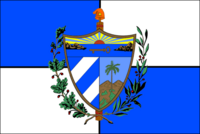Cuba

| |
| Language: | Castilian |
| Capital: | Habana |
| President: | Fidelito "el Martillo" del Castro |
| Independence: | from Castile and Leon |
| Declared: | 1898 |
| Recognized: | 1901 |
| Independence: | from Florida-Caribbea |
| Declared: | 2003 |
| Recognized: | 2003 |
Europeans first learned of Cuba when the Castilian explorer Christopher Columbus arrived on the island in 1492. Diego Velázquez de Cuéllar lead the Castilian conquest of the island. The Castilian settlers established sugar cane and tobacco as Cuba's primary products. As the native Indian population died out, African slaves were imported to work the plantations. Slavery became especially important when Cuba's sugar plantations became important world producers, after the Haytian Revolution of 1791. Cuba and the Floridas began agitating for independance in the mid-19th century. Independance was finally won in the aftermath of the 1898 War. In the early 20th century, Cuba had a series of dictators, culminating in the 1953 Revolution, which the Republic of the Floridas manipulated to place their favored leaders in power, leading to Cuba's annexation by Florida, resulting in the formation of Florida-Caribbea in 1955. Cuba became an important part of Florida-Caribbea in the second half of the 20th century, and the Florida-Caribbean supreme court was relocated to the Cuban capital, La Habana. In the 1960s and 70s, the city became a rival center of economic and political power to the military and legislative capital at Miami.
Cuba extricated itself from the Florida War (2004) by divorcing itself from the junta that had siezed control from Floridian President Jaime Bush and subsequently set off an atomic bomb in the Cruzan Islands.
Cuba reaffirmed its independence both during the chaos of the war and immediately following. After the war, Cuba modified and re-instituted the Constitution of 1953. In the post-war period, Cuba received considerable reconstruction funds from the NAL-SLC and is being prospected as a site for future investment, curiously enough, by former president Bush's younger brother, Nelson M. Bush. As of 2007, the flood of aid money has largely receded as reconstruction has progressed. Cuba has been actively developing its tourism and eco-tourism sectors, as well as its entertainment and banking sectors. It has again become known as the Monte Casino of the Caribbean.
Cuba's current president, chosen by the interim Cortes, is former NAL cricket star Fidelito "el Martillo" del Castro. After a long career pitching with the Pirates and the Trollies and a stint as assistant coach with the Red Stockings, he went home to Cuba and formed a cricket club in La Habana (the Conquistadores) and eventually went into sportscasting. He became politically interested later in life, and is the author of a number of politico type books. He never sought office until 2004, when his celebrity at home and abroad made him an ideal candidate. It is thought that his connexions with the NAL have been a key in securing both foreign aid and military protection.